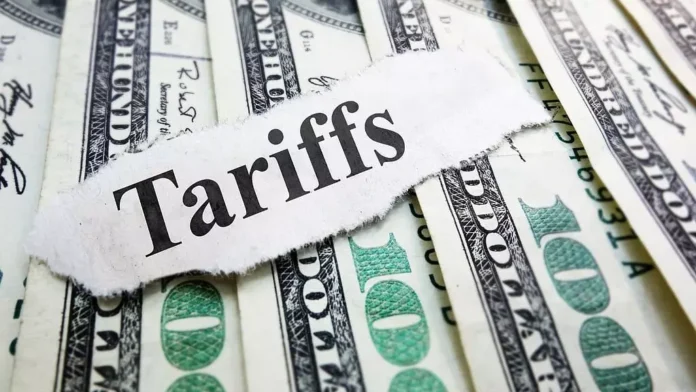The US decision to impose reciprocal tariffs may not significantly impact India, as the measures will target select sectors, according to NITI Aayog Programme Director Pravakar Sahoo. He emphasized that while these tariffs could pose challenges, they might also open new avenues for Indian exporters. India remains better positioned compared to Mexico, China, and Canada, which together account for 50 percent of America’s total imports.
Sahoo shared these insights at the release of the second edition of NITI Aayog’s quarterly Trade Watch. He explained that the government is conducting a detailed analysis to determine the specific impact of the US tariffs on India’s trade. Early findings indicate that the measures will not broadly disrupt India’s export economy. Instead, they could help Indian businesses gain a stronger foothold in the US market by filling gaps created by restrictions on other countries.
India’s diversified export base and growing trade relations with the US offer resilience against potential setbacks from these tariffs. Unlike nations heavily dependent on American imports, India has established a broad range of export sectors that could absorb shifts in global trade policies. Sahoo pointed out that the country’s trade strategy focuses on leveraging its competitive advantages while adapting to changing international dynamics.
The US government has justified the imposition of reciprocal tariffs as a means to level the playing field and protect American manufacturers. However, India’s policymakers see this as an opportunity to strengthen domestic production and explore alternative markets. Experts believe that sectors such as pharmaceuticals, textiles, and software services could remain largely unaffected, while industries dependent on raw materials might experience short-term disruptions.
Government officials are closely monitoring trade data to assess potential risks and opportunities. NITI Aayog’s ongoing evaluation includes consultations with industry leaders and trade experts to ensure that India remains competitive. The Centre is also working on strategies to mitigate any negative effects, including exploring new trade agreements and expanding exports to non-US markets.
Indian exporters remain optimistic about the evolving trade landscape. Many view the reciprocal tariff policy as a shift that could encourage diversification and increased investment in key sectors. While some industries may face hurdles, others could benefit from shifting trade patterns, particularly if the US enforces stricter restrictions on competing nations like China.
India has steadily strengthened its economic ties with the US in recent years. Bilateral trade has grown significantly, and both countries have expressed interest in deepening their commercial partnership. The Indian government has actively engaged in discussions with US trade representatives to ensure that new tariff measures do not disproportionately affect Indian businesses.
The broader impact of the US tariffs will depend on how India adapts to the evolving trade climate. By focusing on strengthening domestic industries and negotiating favorable terms with international partners, the country aims to minimize potential drawbacks while maximizing emerging opportunities.
Policymakers remain confident that India’s economic resilience and diversified export portfolio will allow it to navigate these challenges effectively. Trade experts suggest that the government’s proactive approach in analyzing tariff effects will help businesses adjust to new market conditions. The focus now lies on ensuring that industries receive adequate support to remain competitive in the global market.
Sahoo reiterated that India’s position in the global trade ecosystem remains strong. He highlighted the importance of continuously assessing trade policies and making strategic adjustments to sustain growth. As discussions on the US reciprocal tariffs continue, Indian businesses and policymakers are preparing to adapt and capitalize on new opportunities in the international market.
India’s trade relations with the US have evolved over the years, with both nations recognizing the importance of mutual economic cooperation. While the introduction of reciprocal tariffs may create initial uncertainty, experts believe that India’s established presence in key industries will serve as a buffer against any major disruptions. Policymakers are exploring measures such as tariff negotiations and trade pacts to ensure minimal impact on exporters.
Indian industries that rely on imports from the US may need to reassess their supply chains and explore alternative sourcing options. However, sectors with strong domestic production capabilities could use this as an opportunity to expand their presence in international markets. The government is encouraging businesses to enhance manufacturing capacities and invest in self-reliance to reduce dependency on imports.
Small and medium enterprises (SMEs), which play a crucial role in India’s export sector, may require additional support to navigate the changing trade policies. Industry leaders have called for government interventions such as tax incentives and export subsidies to help smaller businesses remain competitive. Trade organizations are also working with policymakers to develop strategies that align with India’s long-term economic goals.
India’s proactive stance in global trade discussions will be critical in shaping the future of its export economy. The Centre is expected to continue negotiations with the US to ensure that Indian businesses do not face undue disadvantages. As trade policies shift, businesses are being advised to stay informed about tariff changes and adapt their strategies accordingly.
Looking ahead, India’s focus will remain on maintaining its strong trade partnerships while fostering domestic economic growth. The adaptability of Indian exporters and the government’s commitment to mitigating potential risks will play a crucial role in navigating the challenges posed by the US reciprocal tariffs. Despite uncertainties, India’s economic resilience and strategic planning are expected to help it emerge stronger in the evolving global trade landscape.

